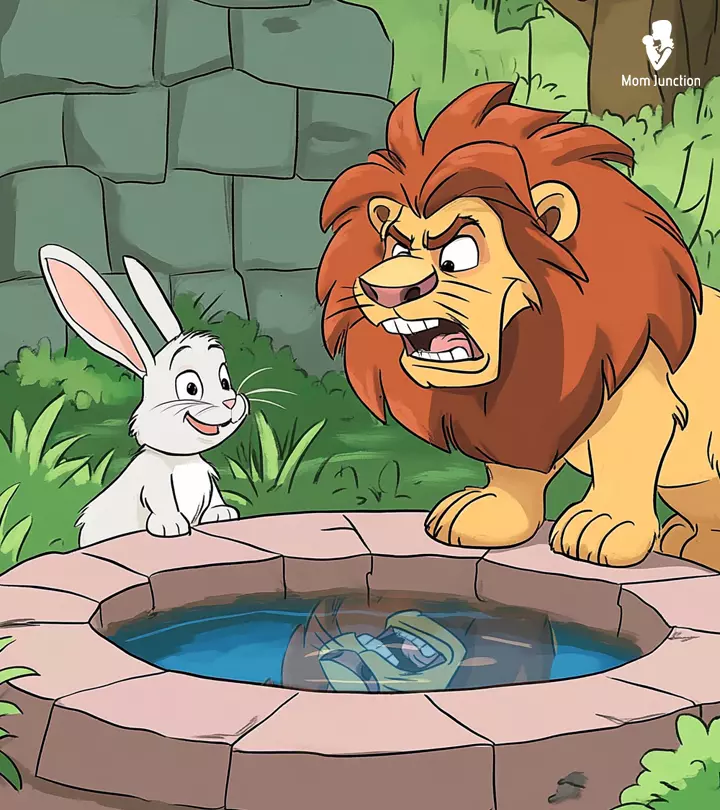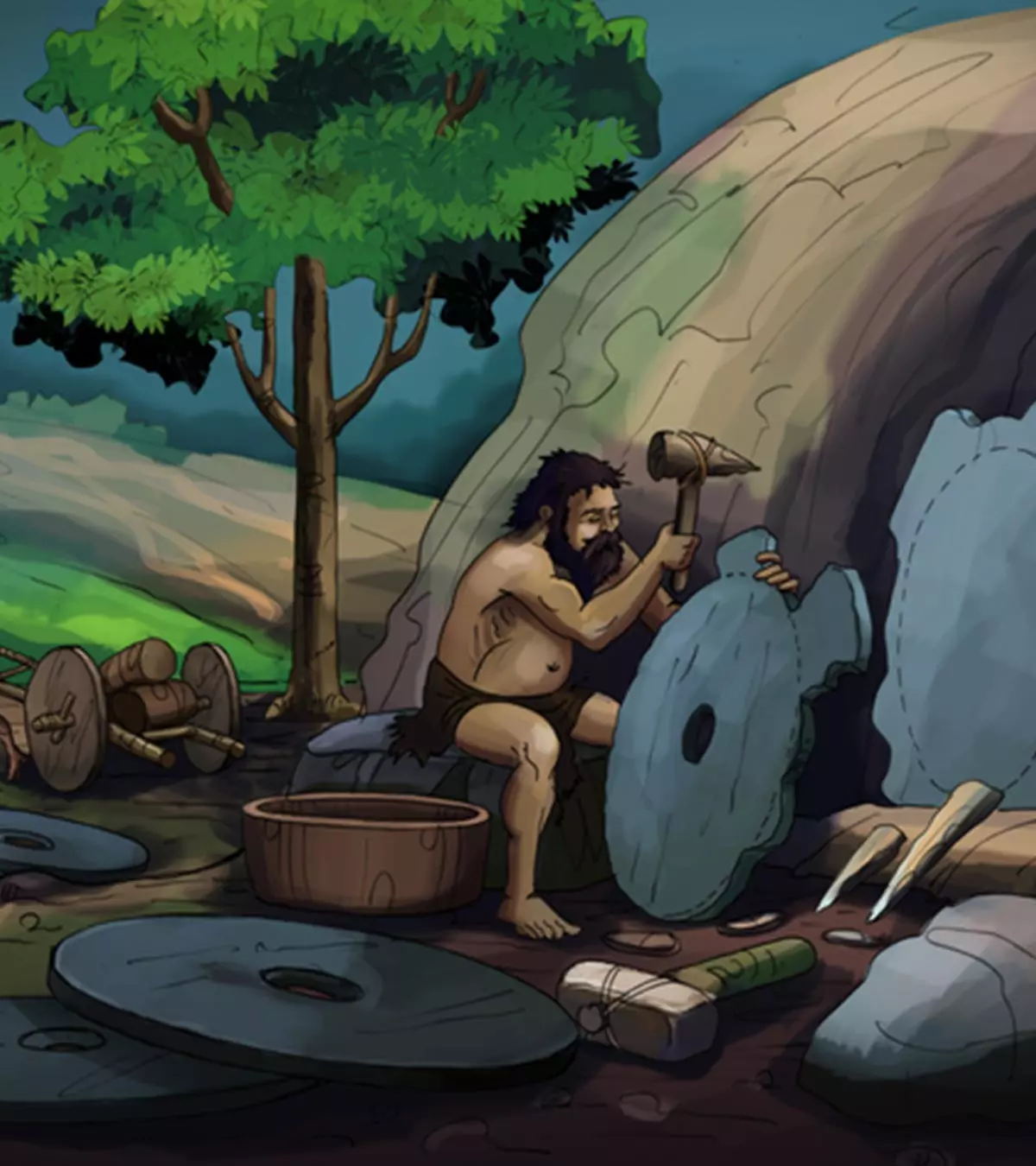
Image: ShutterStock
An interesting prehistoric period with many stories around it, Stone Age facts for kids can help them broaden their historical knowledge and fill them with awe and wonder. It was one of the earliest human civilizations that existed on this planet Also called the age of our ancestors who discovered fire, primitive weapons, and tools. If you wish to teach your kids about the Stone Age, we’ve got some cool Stone Age facts so they understand what life was like then and how much we have evolved over the years. Read on to know more.
Key Pointers
- Fire, primitive weapons, and tools were discovered during the Stone Age, one of the earliest cultures on this planet.
- During the Old Stone Age, men were hunter-gatherers and used tools made of bone, wood, vegetable fibers, and leather.
- The Middle Stone Age saw the development of smaller and finer stone tools like spearheads and arrows, and the beginning of canoe use for hunting and fishing.
- The Neolithic Age marked the beginning of farming, domestication of animals, and settlements.
- Homo sapiens emerged in Africa around 200,000 years ago and could create art on cave walls, make pottery from clay, and grow crops for consumption.
16 Fun Stone Age Facts For Kids
These stone age facts will leave your children in awe and pique their curiosity about this era (1) (2) (3):
1. The Three Periods Of Stone Age
The Stone Age is divided into three periods- the Old Stone or the Paleolithic Age, the Middle Stone or the Mesolithic Age and the New Stone or Neolithic Age. The exact date for each period varies across the world, but it is roughly estimated that the Old Stone Age lasted from the first use of the stone to the end of the last Ice age. During this time, men were hunter-gatherers or even nomadic. They would find food from the local regions and would even migrate, depending on the season. The tools used during this period were mainly made of bone, wood, vegetable fibers, and leather. Even the language was developed to some extent during this time. Some of its early forms are similar to what we hear in the language used by the people of East and South Africa today. The period also witnessed the beginning of art like cave painting and the development of religion.
The Middle Stone Age lasted from the end of the Ice Age until the start of farming. This period saw the development of smaller and finer stone tools like spearheads and arrows. Canoes were made for the first time during this period, which implies that men could hunt as well as fish.
The Neolithic or New Stone Age began from the start of farming until the use of the metal. Animals like sheep and cows were domesticated widely. They were given a ready supply of meat, leather, bone, and milk. Grain was the first food to be stored for an extended period. And storing food meant staying in one place. This led to the development of settlements. Humans also developed crafts such as weaving and pottery during this period. Even large-scale construction took place, and people began taking the roles of fighters, rulers, priests, farmers, and leaders.
 Trivia
Trivia2. The Human Beginnings, the Hominins
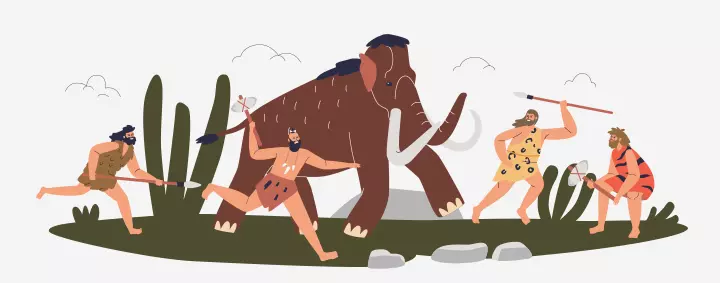
Image: Shutterstock
Around 6 to 7 million years back, a group of apes began walking on two legs. These were the hominins, a group that includes the modern humans and the ancestors. After 3 million years, these creatures began to look like humans. By this time, several hominids appeared, and of several kinds too.
Homo habilis or the ‘skilled man’ was the group of hominins to make tools. They had pretty large brains, and nimble hands with the skill and knowledge to make tools. They used their sharp-edged tools to cut the carcasses of the animals and eat. The Homo habilis lived 2.4 to 1.6 million years.
 Did you know?
Did you know?After 2 million years back a new type of hominin, named Homo erectus, learned how to create fire to keep warm, frighten away the animals and cook meat. They were also the first of our ancestors to have the same body proportion as us. Homo erectus first lived in Africa, but then moved to Europe and Asia. They had large brains and used the hand-made axes to dig the root vegetables out of the ground and chop the meat.
The Neanderthals lived in Asia and Europe during the Ice Ages and died around 24,000 years ago. Neanderthals or Homo neanderthalensis looked very similar to us but had a short stature. They had a big nose, which helped them breathe easily in the freezing conditions and a ridge over the eyebrows. To cope up with winter, they wore clothes made of animal skin and fur. But they were very thoughtful and sensitive. They lived in the family, cared deeply for the sick, and buried the relatives when they died.
3. The Homo Sapiens
Every human in the world today belongs to Homo sapiens, which means ‘wise man.’ Modern humans or Homo sapiens emerged around 200,000 years ago in Africa. It’s said that six other kinds of humans were alive at the same time. But 24000 years back, the Homo sapiens were the only humans left on the earth. After 9000 years, Homo sapiens inhabited every continent of the world, except Antarctica.
The Homo sapiens had slender bodies and large brains. They made art, cave walls with pictures of people and animals, and painted rocks. They even carved the bone in human and animal shapes and even made pottery from clay. After around 5000 years, the Homo sapiens began growing crops and other grains to eat.
4. The Life Of A Hunter-Gatherer

Image: Shutterstock
The hunter-gatherer of the Stone Age ate everything that he found. He moved from one place to another in search of food. The Early Stone Age people hunted with sharp sticks, but they later used spears tipped with bone or flint and arrows and spears. They fished using harpoons and nets. The Stone Age people cut the food with sharp stones and cooked on open fire. They used animal skins to make clothes and for shelter.
5. Homes of the Stone Age people
Human ancestors during the Stone Age period lived primarily in caves, some in groups and some solitary. The shelters made by the Neanderthals also suggest that they lived in wooden huts. Huts made of animal skin over the wooden poles were found in a cave in Grotte du Lazaret in France. Huts with divided living spaces, braced with mammoth bones were found in Serbia, Russia, Ukraine, and France. This is one of the interesting stone age facts for children.
6. The Use Stone Tool
One of the most notable advancements in human history is the use and development of tools. The tools allowed the early humans to progress and become masters of their environment. They used stone tools to protect themselves from animals and to build homes. These tools also helped with gathering food. They made simple hand-axes, chisels, and scrapers out of stone. Antlers and bones were also used to make hammers. The oldest stone tool is said to be around 3.4 million years old. The tool was discovered in the Lower Awash Valley in Ethiopia. They used stones to make fire, for chopping, hunting, and almost everything they did.
7. Stone Age Beliefs

Image: Shutterstock
The early humans developed religious beliefs to explain the world around them. Gatherers and Hunters tried to contact the spirit of the animals that they hunted. As they began farming and settling, they even started making tombs for their ancestors. When they became aware of the changing seasons, they started making up stories regarding thunderstorms and sunrise. They even started worshiping the forces of nature. The large boulder tombs called the megaliths were considered the link between the living and the dead.
8. Stone Age Clothes
The freezing climate of the ice age made clothing essential for the early. They cleaned, prepared and wrapped the animal skins around their bodies to keep them warm. Some even decorated their faces with paints made from natural pigments. Around 75,000 years ago, the early humans made their first jewelry. They used shells, bones, tusks to make bracelets and necklaces. It is one of the interesting stone age clothing facts for kids.
 Trivia
Trivia9. Stone Age Food
Stone Age people lived as hunters and gatherers. So instead of growing food, they went out in search of it. They fished and hunted for food, especially in the Ice Age.
Later, our ancestors learned to gather plants and fruits, take honey from wild beehives, and eggs from bird nests. What the Stone Age people ate depended entirely on what they could find each season. They ate berries and fruits when they ripened and meat from animals when they were plentiful.
They even traveled from one place to the other in search of the best hunting grounds, even if it called for living in temporary shelters. The humans who lived near the rivers, sea and lakes used spears to catch the fish and traps to catch crabs, eels, and lobsters. Eventually, the early humans learned to grow their crops and settle in a place. They became the first farmers.
[ Read: Moon Facts For Kids ]
10. The First Farmers
Around 12,000 years ago, the hunter-gatherers made an incredible discovery. They dug up the ground, threw a few wild seeds, and learned to farm. For the Stone Age people, farming meant controlling the food sources by growing plants and raising animals. They stopped moving in search of food and began settling in one place all year round. The plow was an innovation that changed the farming scene completely. It was invented around 5000 BCE, making it easier to sow the seeds in the ground.
Life became a lot more systematic after the discovery of farming. Large-scale buildings with stalls and straw roofs were built; Stonehenge being a powerful example of it. Pots and pans made out of clay also came into existence.
11. The Ice Age
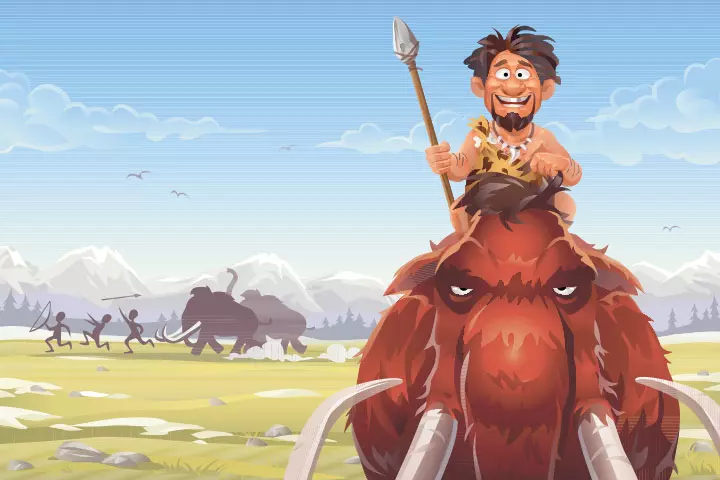
Image: IStock
The Ice Age was the period when temperatures around all over the world dropped. There have been several Ice Ages, including the one that early humans lived through. The Neanderthals living during the Ice Age survived by staying together in groups, building shelters and hunting large animals like mammoths. They adapted well to life in the cold but avoided the frozen glaciers. Instead, they resided mainly on the grasslands and the Tundra.
12. Dogs Were Loved During The Stone Age Too
The dog was the first animal to be domesticated in the Stone Age. It happened for the first time during the Mesolithic period. They would help the humans with hunting, would warn them of the impending dangers, and provide comfort and warmth.
13. Animals Of Stone Age
The Stone Age animals include Saber-toothed cats, cave bears, lions, Smilodon, hyenas, and mammoths. Animals in the Stone Age were a lot larger than their modern counterparts. Saber-toothed cats, Cave bears, and Mammoths were huge. These large animals flourished in the last Ice Age. People hunted these huge animals, mainly for food. They targeted sick, young, or lone animals stuck or trapped in a muddy swamp. After wounding the prey, they waited for it to collapse and then killed it.
Despite what toy manufacturers and cartoonists portray in their shows, there were no dinosaurs in the Stone Age. The vast and majestic animals died around 65 million years ago. There were loads of smaller animals as well, like birds, insects, reptiles and smaller mammals.
14. Art
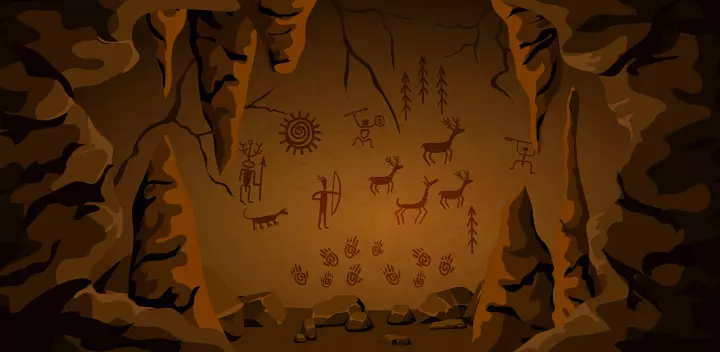
Image: Shutterstock
The early humans used art as an aid in the struggle for survival. Cave paintings became one of the most popular arts of this time. People painted figures of animals in the cave walls. The drawings show stags, horses, birds, bison, and giant bulls. It’s said that the Stone Age people thought that cave painting would bring success in their hunting. Some historians believed that Stone Age paintings had religious significance as well. They believed that the art acted as a call for help from a spirit that they believed in. Not just adults, but even children made cave art.
The Stone Age people also made sculptures from ivory, clay, bones, and carved stone. The famous paintings at Lascaux in France are over 18,000 years old.
A 35,000-year-old flute found in a cave in Germany suggests that the Stone Age people enjoyed making music as well.
15. Stone Age Village That Exists Even Today
Skara Brae, a Neolithic Orkney village near the white beach of Skaill on the West Coast of Orkney is one of the best-preserved groups of the ancient houses. It was uncovered by the storm in 1850. With houses with chairs, beds, cupboards, shelves, and dressers, Skara Brae presents a remarkable picture of life 5000 years ago.
The people of North Sentinel Island are isolated and follow the Stone Age lifestyle even today.
16. World’s Most Famous Human Ancestor
The world’s most famous human ancestor is nicknamed “Lucy”. She was a “southern ape” or “Australopithecus afarensis” as they are scientifically called. The southern ape lived in southern and eastern Africa and animals like giraffes, rhinoceros, buffalo, elephants, and many more. Australopithecus stood two feet tall and left their arms free to carry and throw. Standing upright made the Australopithecus good runners and walkers. Their long arms helped them climb the trees and walk upright. It can be one of the great Stone Age information for kids!
Frequently Asked Questions
1. How long did the Stone Age last?
Stone Age is believed to originate about 2.5 million years ago and ended 3300 BCE (Before the Common Era) years ago (1).
2. What did Stone Age people eat?
In the earliest part of the Stone Age, the Paleolithic period, people ate fruits, plants, and animal meat. Towards the later period, known as the Neolithic period, humans began growing crops in large farmlands (2).
3. How did the Stone Age get its name?
The term “stone age” was coined by Danish scholar Christian J. Thomsen after discovering stone tools in the deepest layer of their archeological dig-up, followed by bronze and iron tools in the top layers (1).
4. Why should children learn about the Stone Age?
The Stone Age is a major milestone in human history that laid the foundation for future civilizations. This era is characterized by the creation and use of stone tools that prehistoric humans used for hunting and gathering. So, when children learn about the Stone Age, they get knowledge about human evolution and culture.
The Stone Age is an important part of human evolution. These facts can increase children’s interest in learning about human evolution and life from prehistoric times. The Stone Age is divided into three periods: paleolithic or Old Stone Age, Mesolithic or Middle Stone Age, and Neolithic or New Stone Age, depending on the type of stone tools used. The Stone Age was when humans used stones as tools, lasting millions of years until metal tools were made. The humans lived in caves, and the period also marked the beginning of arts with stones. Thanks to the archeology department who helped us know about our ancestors.
Infographic: Interesting Stone Age Facts
Learning about our ancestors and how they developed culture, tools, and weapons is intriguing for children. The infographic below highlights some fascinating facts about the stone age that will grab your child’s attention. You may save and share it with parents of other children too!
Some thing wrong with infographic shortcode. please verify shortcode syntaxIllustration: Fun And Fascinating Stone Age Facts For Kids

Image: Stable Diffusion/MomJunction Design Team
Is your child fascinated by the Early Man? Teach them more about prehistoric humans and the Stone Age with this video.
References
- Stone Age;
https://www.google.com/url?sa=t&rct=j&q=&esrc=s&source=web&cd=&cad=rja&uact=8&ved=2ahUKEwjU-KKn07r8AhVN9DgGHbCdCjg4HhAWegQIDBAB&url=https%3A%2F%2Fwww.memphis.edu%2Fmiddleschool%2Fpdfs%2Fstoneagehistory.docx&usg=AOvVaw2LeAEmQkeaHBRhxg-aaBV6 - The Stone Age;
https://www.surreycc.gov.uk/__data/assets/pdf_file/0016/226132/Downloadable-Resource-2-Stone-Age_compressed.pdf
Community Experiences
Join the conversation and become a part of our nurturing community! Share your stories, experiences, and insights to connect with fellow parents.
Read full bio of Elisa Yi
Read full bio of Manjiri Kochrekar
Read full bio of Harshita Makvana
Read full bio of Trisha Chakraborty










